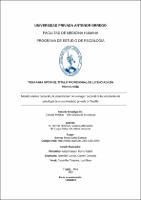Modelo estético corporal y la insatisfacción de la imagen corporal de las estudiantes de psicología de una universidad privada de Trujillo

Date
2023Author(s)
Barreto Neciosup, Vanessa Alessandra
Luque Villacorta, María Fernanda
Metadata
Show full item recordAbstract
El objetivo de la actual investigación científica fue determinar la correlación entre
el Modelo estético corporal y la insatisfacción de la imagen corporal de las estudiantes de
psicología de una universidad privada de Trujillo. La metodología siguió un enfoque de
investigación cuantitativo, nivel descriptivo con diseño correlacional y transaccional.
La muestra quedó constituida por 238 estudiantes entre 19 y 22 años del sexo
femenino seleccionadas aleatoriamente. Se utilizaron los instrumentos: Cuestionario de
influencias del modelo estético corporal (CIMEC 26) y la Evaluación e insatisfacción con
la imagen corporal (IMAGEN).
Recogido los datos se procesaron estadísticamente, obteniendo los siguientes
resultados: rho=0,876; p<0,05; R2=76%, que indicaron la correlación es: positiva, alta y
significativa y de alta variabilidad de explicación de una variable sobre la otra. Por tanto,
se rechazó la hipótesis nula y aceptó la hipótesis de investigación concluyendo que existe
una relación significativa entre el modelo estético y la insatisfacción de la imagen
corporal. También, se determinó que la dimensión malestar por la imagen corporal
evidenció mayor correlación significativa. Asimismo, el indicador cognitivo emocional
fue el que mayor correlación significativa presentó con las dimensiones del modelo
estético corporal, donde las evaluadas mostraron preocupación por el peso corporal y la
delgadez. The present research is aimed to determine the correlation between the aesthetic
body model and body image dissatisfaction among psychology students of a private
university in Trujillo. The methodology followed a quantitative research approach,
descriptive level with correlational and transactional design.
The sample consisted of 238 randomly selected female students between 19 and 22 years
of age. The following instruments were used: Body Aesthetic Model Influences
Questionnaire (CIMEC 26) and the Evaluation and Dissatisfaction with Body Image
(IMAGEN).
Collected data were statistically processed, obtaining the following results: rho=0.876;
p<0.05; R2=76%, which indicated the correlation is: positive, high and significant and of
high variability of explanation of one variable over the other. Therefore, the null
hypothesis was rejected and accepted the research hypothesis concluding that there is a
significant relationship between the aesthetic model and body image dissatisfaction. Also,
it was determined that the body image dissatisfaction dimension showed a significant
correlation. Likewise, the cognitive emotional indicator showed the highest significant
correlation with the dimensions of the aesthetic body model, where the evaluated women
showed concern for body weight and thinness.
Collections
- Psicología [531]

